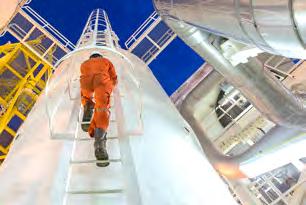A
SHORTAGE OFEVERYTHING A ‘perfect storm’ exposes fragility of Louisiana’s industrial supply chain BY SAM BARNES
I
t came as a surprise to many that Louisiana’s industrial supply chain was so vulnerable. A series of unfortunate and unthinkable events in 2020 and 2021 severely disrupted its reliability at nearly every level, and led to shortages in everything from steel, raw materials and industrial valves to skilled laborers and drivers. The COVID-19 pandemic caused much of it, but not all. Shutdowns in upstream manufacturing facilities kicked it off, only to be followed by a range of transportation issues—including shipping delays at multiple West Coast ports, rail bottlenecks and an alarming lack of trucks. In South Louisiana, all of that was exacerbated by the impacts of three catastrophic hurricanes in only 12 months, and a host of other weather scares. “COVID is bad enough, but dealing with multiple hurricanes, an ice storm and flood haven’t helped things,” says George Swift, president/CEO of the Southwest Louisiana Economic Development Alliance in Lake Charles. “Those areas of Louisiana that have been impacted by hurricanes Laura, Delta and Ida are suffering from amplified supply chain problems, as they’ve impacted the delivery and price of everything. “Everything in Lake Charles is on back order,” he adds. “It’s that way everywhere you look.” The disruptions are playing out in troubling fashion in the industrial space. Some South Louisiana chemical plants aren’t meeting production goals because they can’t get raw materials. And industrial facilities all along the Gulf Coast are delaying scheduled maintenance turnarounds and capital projects into 2022—after already pushing them back a year—because of
1012industryreport.com
rapid inflation and an unpredictable supply. The fragility of the supply chain has come as a shock, says Mark Zappi, dean of engineering and executive director of the Energy Institute at the University of Louisiana at Lafayette. “I’m surprised at how sensitive our supply chain ended up being,” Zappi says. “Admittedly, there’s been somewhat of a perfect storm: COVID-19, some ugly elections and the hurricanes. Everything has lined up against us. But still, I’m surprised at how fragile our system really is.” It’s the expectation of an efficient supply chain that has actually caused the problem, says economist Loren Scott of Loren C. Scott & Associates in Baton Rouge. “The second quarter gross domestic product was forecast to grow at 9 percent, but it only grew by 6,” Scott adds. “That’s largely because they were off on their forecast of ‘change in business inventories.’ What normally happens when you’re coming out of a recession is that there’s a huge buildup of inventories. That’s one of the things that pumps up GDP.” In the past, the U.S. benefitted from a “finely honed supply chain, but that’s part of the current problem,” Scott says. “Many in industry have developed very sophisticated ‘just-in-time’ inventory systems. That works great when things are running smoothly, but when something like COVID comes along, it falls apart. That’s exactly where we are right now.” RETHINKING THE SUPPLY CHAIN For the first time, it’s prompting a serious discussion among manufacturers, distributors and industrial customers about shaking up the supply chain and “rethinking” where materials 10/12 INDUSTRY REPORT • FALL 2021 17







